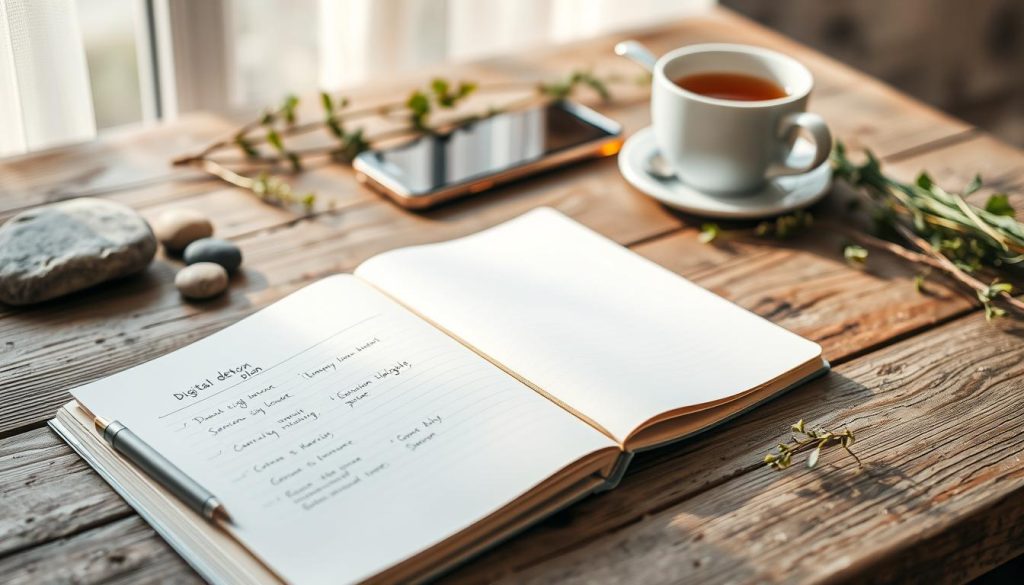In today’s technology-driven world, it’s easy to get caught up in the endless stream of notifications, social media updates, and emails. However, excessive screen time can lead to increased stress and anxiety, negatively impacting our mental health.
A digital detox can be a powerful tool in combating technology addiction and promoting mental well-being. By disconnecting from our devices, we can reduce feelings of overwhelm and improve our overall quality of life.
Key Takeaways
- Excessive screen time can lead to increased stress and anxiety.
- A digital detox can help reduce feelings of overwhelm.
- Disconnecting from devices can improve mental well-being.
- Technology addiction is a growing concern.
- Implementing digital detox strategies can promote better mental health.
The Rising Tide of Digital Overwhelm
In today’s digital age, the line between being connected and being overwhelmed is increasingly blurred. The constant bombardment of notifications, the endless scroll through social media, and the pressure to be always available are taking a toll on mental health.
Statistics on Screen Time in America
A recent survey found that Americans spend an average of 4 hours and 25 minutes on their phones daily. This staggering statistic highlights the extent to which digital technology has permeated daily life.
| Age Group | Average Screen Time |
|---|---|
| 18-24 | 5 hours 30 minutes |
| 25-34 | 5 hours |
| 35-44 | 4 hours 45 minutes |
The Psychological Impact of Constant Connectivity
The psychological effects of being constantly connected are multifaceted, affecting attention span and sleep patterns.
Attention Fragmentation
Constant notifications can lead to attention fragmentation, making it difficult to focus on a single task. This can result in decreased productivity and increased stress levels.
Exposure to screens and the constant notifications can disrupt sleep patterns, leading to sleep deprivation. This can have serious implications for overall health and wellbeing.
Understanding these impacts is crucial for adopting strategies to mitigate digital overwhelm.
Understanding Digital Detox Strategies for Better Mental Health
The concept of digital detox has gained significant attention in recent years as a means to counteract the negative effects of excessive screen time. As we continue to navigate the complexities of the digital age, understanding digital detox strategies is crucial for maintaining better mental health.
Defining Digital Detox in Modern Context
Digital detox refers to the practice of abstaining from digital devices and technologies for a period of time. This can range from a few hours to several days or even weeks. The goal is to reduce the stress and anxiety caused by constant connectivity and to promote a healthier balance between technology use and other aspects of life.
In the modern context, digital detox is not just about disconnecting from devices; it’s about reconnecting with oneself and the world around us. It involves being mindful of our digital consumption and making conscious choices to limit our exposure to digital stimuli.
The Science Behind Digital Overload and Mental Health
Research has shown that excessive screen time can lead to changes in the brain’s structure and function, contributing to digital overload. This condition is characterized by feelings of anxiety, stress, and overwhelm due to the constant bombardment of digital information.
Neurological Effects of Excessive Screen Time
Excessive screen time has been linked to various neurological effects, including:
- Reduced attention span
- Increased stress levels
- Disrupted sleep patterns
These effects can have a significant impact on mental health, contributing to conditions such as anxiety and depression.
Research on Technology and Mental Wellbeing
Studies have consistently shown a correlation between technology use and mental wellbeing. For instance, research has found that excessive social media use can lead to feelings of loneliness and isolation. Conversely, moderate and mindful technology use can have positive effects on mental health.
By understanding the science behind digital overload and its impact on mental health, we can better appreciate the importance of digital detox strategies. These strategies offer a pathway to mitigating the negative effects of excessive screen time and promoting a healthier, more balanced lifestyle.
Signs You Need a Digital Detox
The constant connectivity offered by modern technology can be both a blessing and a curse, making it vital to recognize when it’s time to unplug. As our reliance on digital devices grows, so does the risk of falling into unhealthy patterns of use.
Physical Symptoms of Digital Overuse
Excessive screen time can lead to a variety of physical symptoms that signal the need for a digital detox. Two of the most common issues are:
Eye Strain and Headaches
Prolonged screen time can cause eye strain and headaches due to the blue light emitted by digital devices. This is often exacerbated by poor screen brightness and positioning.
Disrupted Sleep Patterns
The blue light from screens can also interfere with your body’s production of melatonin, leading to disrupted sleep patterns. This can have a ripple effect on your overall health and well-being.
Psychological Warning Signs
Beyond the physical symptoms, there are several psychological indicators that you might need a digital detox. These include:
- Anxiety and FOMO (Fear of Missing Out): Constantly feeling the need to check notifications can lead to increased anxiety levels.
- Decreased Attention Span: The constant stream of information can make it difficult to focus on a single task for an extended period.
Anxiety and FOMO (Fear of Missing Out)
The pressure to stay constantly connected can lead to feelings of anxiety and a persistent fear of missing out on important events or updates.
Decreased Attention Span
The constant bombardment of information from digital sources can erode your ability to concentrate, leading to a decreased attention span.
Social Relationship Indicators
Finally, the impact of digital overuse on your social relationships can also be a significant indicator that it’s time for a digital detox. Consider whether your digital habits are:
- Affecting your face-to-face relationships.
- Causing you to neglect important social interactions.
- Leading to feelings of isolation despite being constantly connected.
Recognizing these signs is the first step towards making a positive change. By being aware of the physical, psychological, and social indicators that you’re due for a digital detox, you can take proactive steps to improve your digital habits and overall well-being.
Creating a Personalized Digital Detox Plan
To reap the benefits of a digital detox, it’s crucial to develop a tailored plan that addresses your specific digital consumption patterns. This involves a thoughtful assessment of your current digital habits and setting realistic goals that align with your lifestyle.
Assessing Your Digital Consumption Patterns
Understanding how you use digital technology is the first step towards creating an effective digital detox plan. Start by tracking your screen time, identifying the apps and platforms you use most, and noting the times of day when you’re most digitally active.
Key areas to assess include:
- Daily screen time
- Most used apps and platforms
- Times of peak digital activity
- Purposes of digital use (work, entertainment, socializing)
Setting Realistic Goals and Boundaries
Once you have a clear picture of your digital consumption patterns, set achievable goals for reducing your digital engagement. These goals should be specific, measurable, and aligned with your personal and professional needs.
For example:
- Limiting social media use to specific times of the day
- Designating tech-free zones in your home
- Establishing a consistent bedtime routine that doesn’t involve screens
Tailoring Strategies to Your Lifestyle
Different individuals have different needs when it comes to digital detox. Professionals with high digital demands, parents, and families will each require tailored strategies.
For Professionals with High Digital Demands
For those whose work heavily involves digital technology, a digital detox plan might focus on managing work-related screen time while maintaining productivity.
| Strategy | Benefit |
|---|---|
| Implementing app blockers during work hours | Improved focus and productivity |
| Scheduling regular digital breaks | Reduced eye strain and mental fatigue |
| Setting boundaries around work-related digital use outside work hours | Enhanced work-life balance |
For Parents and Families
For families, a digital detox plan can help create healthier digital habits for both children and adults.
Strategies include:
- Creating a family media plan that sets limits on screen time
- Engaging in digital-free family activities
- Modeling healthy digital behavior for children

By tailoring your digital detox plan to your specific needs and lifestyle, you can more effectively manage digital overwhelm and improve your overall wellbeing.
Daily Digital Detox Practices
Daily digital detox practices offer a straightforward way to reduce stress and improve mental clarity. By incorporating simple yet effective strategies into your daily routine, you can significantly enhance your overall wellbeing.
Morning and Evening Tech-Free Rituals
Starting and ending your day with tech-free rituals can set a positive tone for the day and promote a restful night’s sleep. Morning rituals might include meditation, journaling, or a short walk, while evening rituals could involve reading, relaxation techniques, or spending quality time with family.
The First Hour Rule
Implementing the “First Hour Rule” means avoiding screens for the first hour after waking up. This allows you to begin your day with a clear mind and sets a positive tone for the day ahead.
Digital Sunsets
Similarly, “Digital Sunsets” involve powering down your devices a couple of hours before bedtime to improve sleep quality. This practice helps your brain wind down and prepares your body for rest.
Mindful Technology Usage Techniques
Being mindful of how you use technology is crucial in today’s digital age. Techniques such as single-tasking and notification management can help you stay focused and avoid unnecessary distractions.
Digital Minimalism in Everyday Life
Embracing digital minimalism means being intentional about the technology you use and the content you consume. This involves simplifying your digital life, reducing clutter, and focusing on what’s truly important.
Single-Tasking vs. Multi-Tasking
Focusing on a single task at a time can improve productivity and reduce stress. Unlike multi-tasking, which can lead to divided attention and decreased efficiency, single-tasking allows you to dedicate your full attention to the task at hand.
Notification Management
Effectively managing notifications is key to minimizing distractions. This can involve turning off non-essential notifications, using “do not disturb” modes, and scheduling specific times to check messages and emails.
By integrating these daily digital detox practices into your life, you can enjoy a healthier relationship with technology and improve your mental wellbeing.
Weekend and Extended Digital Detox Approaches
As we navigate the complexities of modern life, digital detoxes have become an essential tool for maintaining mental wellbeing. Taking a break from our devices can help us recharge and gain a fresh perspective on our lives.
48-Hour Technology Breaks
A 48-hour technology break can lead to significant improvements in mental health and wellbeing. By abstaining from digital devices for just two days, individuals can experience reduced stress levels, improved sleep quality, and increased productivity. To make the most of a 48-hour break, consider planning device-free activities such as outdoor adventures, reading, or spending quality time with loved ones.
Nature-Based Detox Retreats
Nature-based detox retreats offer a unique opportunity to disconnect from the digital world and reconnect with nature. These retreats often take place in serene, natural environments and provide a range of activities such as hiking, meditation, and yoga. By immersing oneself in nature, individuals can experience a deeper sense of calm and relaxation.
Structured Detox Programs
For those seeking a more guided approach to digital detox, structured detox programs can be an excellent option. These programs often include a combination of workshops, group activities, and individual coaching to help participants navigate the challenges of digital detox.
Guided Programs in the United States
The United States offers a variety of guided digital detox programs, ranging from luxury retreats to community-based initiatives. Some popular options include digital detox centers in California and wellness retreats in the mountains of Colorado. These programs provide a supportive environment for individuals to disconnect from their devices and focus on their wellbeing.
Self-Directed Extended Detox Plans
For those who prefer a more independent approach, self-directed extended detox plans can be a viable option. This involves creating a personalized plan, setting clear goals, and establishing boundaries around digital device use. By being intentional and mindful, individuals can successfully navigate an extended digital detox on their own terms.
Some key tips for a successful digital detox include:
- Setting clear goals and boundaries
- Planning device-free activities
- Creating a supportive environment
- Being mindful of digital device use

Overcoming Digital Detox Challenges
The path to a successful digital detox is fraught with challenges, from withdrawal symptoms to social pressures. As individuals embark on this journey, they often encounter unexpected hurdles that can test their resolve.
Managing Withdrawal Symptoms
One of the initial challenges of digital detox is managing withdrawal symptoms. These can range from anxiety and restlessness to the fear of missing out (FOMO). To mitigate these effects, it’s essential to establish a routine that includes relaxation techniques such as meditation or deep breathing exercises.
Dealing with Work Expectations
Work expectations can significantly impact one’s ability to maintain a digital detox. It’s crucial to communicate your digital detox plans with your employer and colleagues to set realistic expectations. Establishing boundaries, such as specific times when you are unavailable, can help in managing work-related stress during this period.
Navigating Social Pressures
Social pressures are another significant challenge. Friends and family may not understand the reasons behind your digital detox, leading to feelings of isolation or frustration.
When Friends and Family Don’t Understand
When faced with unsupportive friends and family, it’s helpful to explain the reasons behind your digital detox in a clear and non-judgmental way. Sharing your goals and the benefits you’re experiencing can help others understand your perspective.
Strategies for Social Media Boundaries
Setting boundaries on social media is also crucial. This can include limiting your screen time, using website blockers, or scheduling your social media use. By being proactive about your online presence, you can reduce the pressure to be constantly connected.
| Challenge | Strategy |
|---|---|
| Withdrawal Symptoms | Relaxation Techniques |
| Work Expectations | Communicate Plans |
| Social Pressures | Set Boundaries |
By understanding these challenges and implementing strategies to overcome them, individuals can successfully navigate their digital detox journey and enjoy the benefits of a healthier digital lifestyle.
Technology Tools That Support Digital Wellness
As we navigate the complexities of modern technology, tools that support digital wellness are becoming increasingly important. The digital landscape is filled with distractions, making it challenging to maintain a healthy balance between technology use and mental wellbeing.
Screen Time Monitoring Apps
Screen time monitoring apps are designed to track and manage the amount of time spent on devices. These apps provide insights into usage patterns, helping users identify areas for improvement.
- Freedom: Blocks distracting apps across all devices.
- Moment: Tracks device usage and provides daily/weekly reports.
- RescueTime: Automatically tracks time spent on apps and websites.
Digital Wellbeing Features on Popular Devices
Both Apple and Android devices offer built-in digital wellbeing features to help users manage their screen time more effectively.
Apple Screen Time Settings
Apple’s Screen Time feature provides detailed reports on device usage, allowing users to set limits on app usage and schedule downtime.
Android Digital Wellbeing Tools
Android’s Digital Wellbeing tools offer similar functionality, including app timers, a dashboard for tracking usage, and a focus mode to minimize distractions.
Focus and Productivity Tools
In addition to monitoring screen time, various tools are available to enhance focus and productivity. These include website blockers and apps designed to help users stay on track.
| Tool | Description | Platform |
|---|---|---|
| Freedom | Blocks distracting apps and websites. | iOS, Android, Mac, Windows |
| StayFocusd | A Chrome extension that limits time on distracting websites. | Chrome |
| Forest | Grows a virtual forest as you stay focused on tasks. | iOS, Android |
By leveraging these technology tools, individuals can take a proactive approach to digital wellness, fostering a healthier relationship with technology.
Conclusion
Implementing digital detox strategies can lead to significant improvements in mental health and wellbeing. By understanding the signs that indicate a need for digital detox and creating a personalized plan, individuals can take the first steps towards a healthier digital lifestyle.
Daily digital detox practices, such as morning and evening tech-free rituals, and mindful technology usage techniques, can help reduce digital overwhelm. Weekend and extended digital detox approaches, including nature-based detox retreats, can also be beneficial.
By adopting these strategies, individuals can experience the digital detox benefits, including improved mental health and digital wellbeing. Maintaining a healthy balance between technology use and mental wellbeing is crucial in today’s digital age.
Start your digital detox journey today and discover a more balanced, healthier you. With the right tools and strategies, achieving digital wellbeing is within reach.






